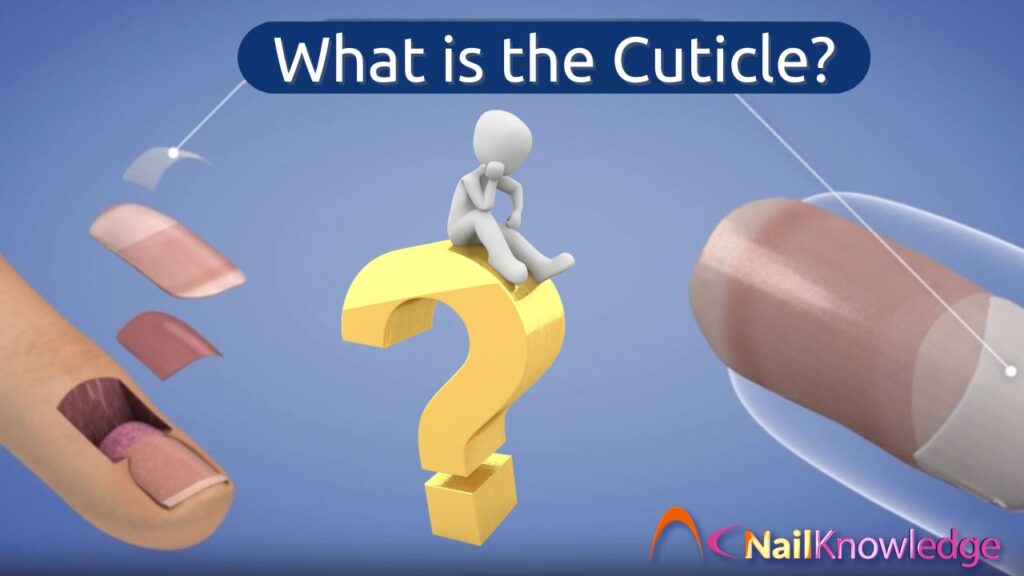When people ask what is the cuticle, they often picture the skin at the base of the nail that sometimes becomes dry or ragged. In reality, the cuticle is one of the most misunderstood parts of the nail unit. Knowing what is the cuticle and understanding its role is essential for keeping nails healthy, preventing problems, and protecting the nail matrix from damage.
This guide will explain the cuticle in clear language, define related nail anatomy terms, and give practical tips for keeping this area in good condition.
What Is the Cuticle? Explained in Simple Terms
The cuticle is a thin, transparent layer of dead skin cells. It grows out from underneath the Proximal Nail Fold (PNF) and sticks to the nail plate. The PNF is the band of living skin at the base of your nail. The nail plate is the hard part you see and trim.
Think of the cuticle as a delicate, see-through strip of clingfilm. Sitting on top of the nail plate, it marks the point where the nail meets the skin. Unlike living skin, the cuticle has no blood vessels. Softer than normal skin, it is only partly keratinised.
Proximal Nail Fold (PNF): The protective living skin at the base of the nail. It acts like a shield for the ma trận móng tay, which is the hidden part under the skin that makes new nail cells.
Nail Plate: The visible, hard nail surface made of layers of keratin. It grows out from the nail matrix and carries the cuticle với nó.
What the Cuticle Is Not
Many people think the cuticle is the thicker skin you can see sitting on top of the PNF, but that is not correct. That thickened skin is usually hyperkeratosis, not cuticle.
Hyperkeratosis: A thickening of the outer layer of living skin caused by an overproduction of keratin. On the nails, this can happen when the PNF becomes dry or irritated and starts producing extra layers of skin. It feels rough or crusty and can be reduced with gentle care, but it is not attached to the nail plate.
The real cuticle always attaches to the nail plate, never to the living skin above it. If it is on the nail plate, it is cuticle. If it is on the PNF, it is hyperkeratosis.
The Role of the Cuticle in Nail Health
The main purpose of the cuticle is protection. It acts as a natural seal between the nail plate and the PNF, blocking bacteria, fungi, and chemicals from entering the gap and reaching the nail matrix.
An infection or injury to the matrix can permanently affect nail growth. That is why scientists compare the cuticle to a gasket on a jar lid. If the seal is broken, unwanted substances can get inside.
Nail Matrix: The hidden section under the skin where new nail cells are made. If injured, it can cause ridges, dents, or permanent nail deformities.
How the Cuticle Forms
Research shows that special stem cells located at the back edge of the PNF near the nail matrix called the eponychium produce the cells that become cuticle. These cells move forward from under the PNF and attach themselves to the nail plate as it grows out.
Normally, the cuticle is only two or three layers of cells thick. However, if the eponychium area is injured or irritated, the cuticle can become temporarily thicker, sometimes reaching up to five or six layers.
Risks of Over-Manicuring
Some people like the look of nails with the proximal nail fold completely removed. But cutting or scraping away too much can cause problems. Removing the cuticle too aggressively weakens the protective seal. This makes it easier for bacteria and fungi to get in. The result is a higher risk of infection and inflammation around the nail.
Because the cuticle is made of dead tissue, you can carefully remove it from the nail plate without causing bleeding. However, it is important to be gentle and avoid damaging the living skin of the PNF.
Caring for the Cuticle
Healthy cuticles keep nails strong and reduce the risk of infection. Here are some simple ways to care for them:
- Moisturise regularly: Use a good nail and skin oil or a rich hand cream daily to keep the area flexible and prevent dryness.
- Soften before care: If you want to push back the cuticle for a neat look, soften it first in warm water or with a cuticle remover product.
- Push gently: Use a soft tool like a rubber cuticle pusher rather than a sharp metal instrument.
- Avoid aggressive cutting: Trim only loose, dead skin that is clearly detached from the PNF.
- Protect from chemicals: Wear gloves when cleaning or using harsh products to avoid irritating the cuticle and PNF.
Myths About the Cuticle and Nail Care
Huyền thoại: The cuticle is the same as the skin around the nail
Truth: The cuticle is dead skin attached to the nail plate, while the skin around the nail is living tissue.
Huyền thoại: Removing the cuticle makes nails healthier
Truth: The cuticle’s job is to protect the nail matrix. Over-removal can make nails weaker and more prone to infection.
Huyền thoại: Nail and skin oil is just for looks
Truth: Oils keep the cuticle soft and prevent it from lifting, which helps maintain the protective seal.
Respect the Cuticle for Stronger Nails
Once you understand what the cuticle is and how it works, it becomes clear that it is more than just a strip of skin. In fact, knowing what is the cuticle fully shows how vital it is as a built-in defence system for your nails. Treating it gently and keeping it healthy will help maintain strong, smooth, and problem-free nails.
When someone asks you what is the cuticle, you can now explain that it is the thin, transparent strip of dead skin on the nail plate, shed from underneath the proximal nail fold, and that its main purpose is to protect the nail matrix from harm.


